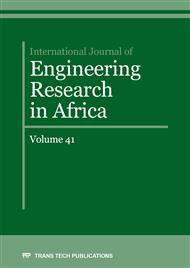[1]
A. Tafraoui, G Escadeillas, S Lebaili, T. Vidal, Metakaolin in the formulation of UHPC. Construction and Building Materials 23 (2009), p.669 – 674.
DOI: 10.1016/j.conbuildmat.2008.02.018
Google Scholar
[2]
P. Mikhailenko, F. Cassagnabere, A. Emam, M. Lachemi, Influence of physico-chemical characteristics on the carbonatation of cement past at high replacement rates of metakaolin, Construction and building materials (2017).
DOI: 10.1016/j.conbuildmat.2017.10.021
Google Scholar
[3]
B.B. Sabir, S. Wild, J. Bai, Metakaolin and calcined clays as pozzolans for concrete. Cement and Concrete Research, Vol. 23 (2001) p.441.
DOI: 10.1016/s0958-9465(00)00092-5
Google Scholar
[4]
P.Rougeau, B. Borys, Réaliser des produits en béton à très hautes performances ou fibres à ultra hautes performances avec des ultrafines autres que les fumées de silice, Document CERIB, Réf.DDP 114 (2004).
Google Scholar
[5]
J.M. Khatib, B.B. Sabir, S. Wild, Some properties of metakaolin paste and mortar Concrete for environment enhancement and Protection, Ed. R.K. Dhir and T.D. Dyer, Sponpress, London (1996).
Google Scholar
[6]
C.S. Poon, I. Lam, S.C. Kou, Y.L. Wong, R. Wong, Rate of pozzolanic reaction of metakaolin in high-performance cement pastes, Cement and Concrete Research, Vol. 31 (2001), pp.1301-1306.
DOI: 10.1016/s0008-8846(01)00581-6
Google Scholar
[7]
S. Wild, J.M. Khatib, A. Jones, Relative strenght, pouzzolanic activity and cement hydration in superplasticized metakaolin concrete, Cement and concrete ressearch, Vol 26 (1996), pp.1537-1544.
DOI: 10.1016/0008-8846(96)00148-2
Google Scholar
[8]
K. Salhi., B. Mezghiche, Evaluation of the mechanical properties and durability of cement mortar containing Algerian metakaolin, Ceramics Silikàty, 61 (1) (2017), 65-73.
DOI: 10.13168/cs.2016.0062
Google Scholar
[9]
R. San Nicolas, Approche performantielle des bétons avec metakaolin obtenus par calcination flash, Thèse de Doctorat, Université de Toulouse, (2011).
Google Scholar
[10]
S. Djaknoun, E. Ouedraogo, A. Ahmedbenyahia, Characterisation of the behavior of high performance mortars subjected to high temperature, Construction and Building Materials 28 (2012), p.176–186.
DOI: 10.1016/j.conbuildmat.2011.07.063
Google Scholar
[11]
V. Nguyen. Comportement des bétons ordinaires et à hautes performances soumis à hautes températures, application à des éprouvettes de grandes dimensions, Thèse de Doctorat, Université de Cergy Pontoise (2013).
Google Scholar
[12]
I. Hager, Behavior of cement concrete at high temperature, Bulletin of polish academy of sciences technical sciences, Vol 61, N° 1 (2013).
DOI: 10.2478/bpasts-2013-0013
Google Scholar
[13]
M. Saridemir, H. Serereau, M. Çifliki, S. Çelikten, Microstructural analyses of high strength concretes containing metakaolin at high temperature, International journal of civil engineering, 15 (2017), 273-285.
DOI: 10.1007/s40999-016-0081-7
Google Scholar
[14]
K. Varun Teja, T. Meena, A. Narender Reddy, Investigation on metakaolin and silice fume incorporated concrete under elevated temperature, IJCMS, volume 7,issue I (2018).
Google Scholar
[15]
C. Bich, Contribution à l'étude l'activation thermique du kaolin, évolution de la structure cristallographique de l'activité pouzzolanique, Thèse de Doctorat, Institut national des sciences appliquées de lyon (2005).
Google Scholar
[16]
M. Septfons, T. Risson, S. Maximilien, Composition de béton a poudres réactives et préparation d'une pièce à partir de celle-ci, Fascicule de brevet Européen, Date de publication et mention de la délivrance du brevet 15.08.2012, Bulletin (2012).
DOI: 10.1515/9783110805680-006
Google Scholar
[17]
J. Dugat, N. Roux, G. Bernier, Etude expérimentale de la déformation sous contraintes et du comportement contrainte de rupture du BPR, Annales de l'institut technique du bâtiment et travaux publics N°532/série Béton 320 (1995), p.112 à 121.
DOI: 10.3166/rfgc.6.709-722
Google Scholar
[18]
G. Batis, P. Pantazoupoulou, S. Tsilivis, E. Badogiannis, The effect of metakaolin on the corrosion behaviour of cement mortars, Cement and concrete composites, Vol.27 (2005), pp.125-130.
DOI: 10.1016/j.cemconcomp.2004.02.041
Google Scholar
[19]
G. Baker, The effect of exposure to elevate temperature on the fracture energy of plain concrete. Materials and structures, Vol 29 (1999), pp.383-388.
Google Scholar
[20]
A.Menou, Etude du comportement thermos-mécanique des bétons à haute température, Thèse doctorat de Pau et des pays de l'ADOUR (2004).
Google Scholar
[21]
N.A. Noumowé, Effet de hautes températures (20°C-600°C) sur le béton. Cas particulier du BHP, Thèse de Doctorat de l'INSA de Lyon (1995).
Google Scholar
[22]
A. Hillerborg, The theoretical basis of a method to determine the fracture energy Gf of concrete. Matériaux et constructions, Vol 18-N°106 (1985), pp.291-296.
Google Scholar
[23]
RILEM (Draft recommendation), Determine of the fracture energy of mortar and concrete by means of three-point bend tests on notched beams. Materials and structures 18 (106) (1985), 285-290.
DOI: 10.1007/bf02498757
Google Scholar
[24]
M. Elices, G V. Guinea, J. Plames, On the measurement of concrete fracture energy using three-point bend tests, Materials and structures, Vol 30 (1997), pp.375-376.
DOI: 10.1007/bf02480689
Google Scholar
[25]
M. Castellote, C. Alonso, C. Andrade, X. Turillas, J. Campo, Composition and microstructural. changes of cement pastes upon heating, as studied by neutron diffraction, Cement and Concrete Research, 34(9) (2004), 1633–1644.
DOI: 10.1016/s0008-8846(03)00229-1
Google Scholar
[26]
L. Divet, Présentation des techniques de diagnostic de l'état d'un béton soumis à un incendie. Techniques et méthodes des Laboratoires des Ponts et Chaussées (2005).
DOI: 10.4000/histoire-cnrs.435
Google Scholar
[27]
M. Moisson, Contribution à la maitrise alcali-silice par ajout de fines granulats réactifs dans le béton, Thèse Doctorat, INSA Toulouse (2005).
Google Scholar


